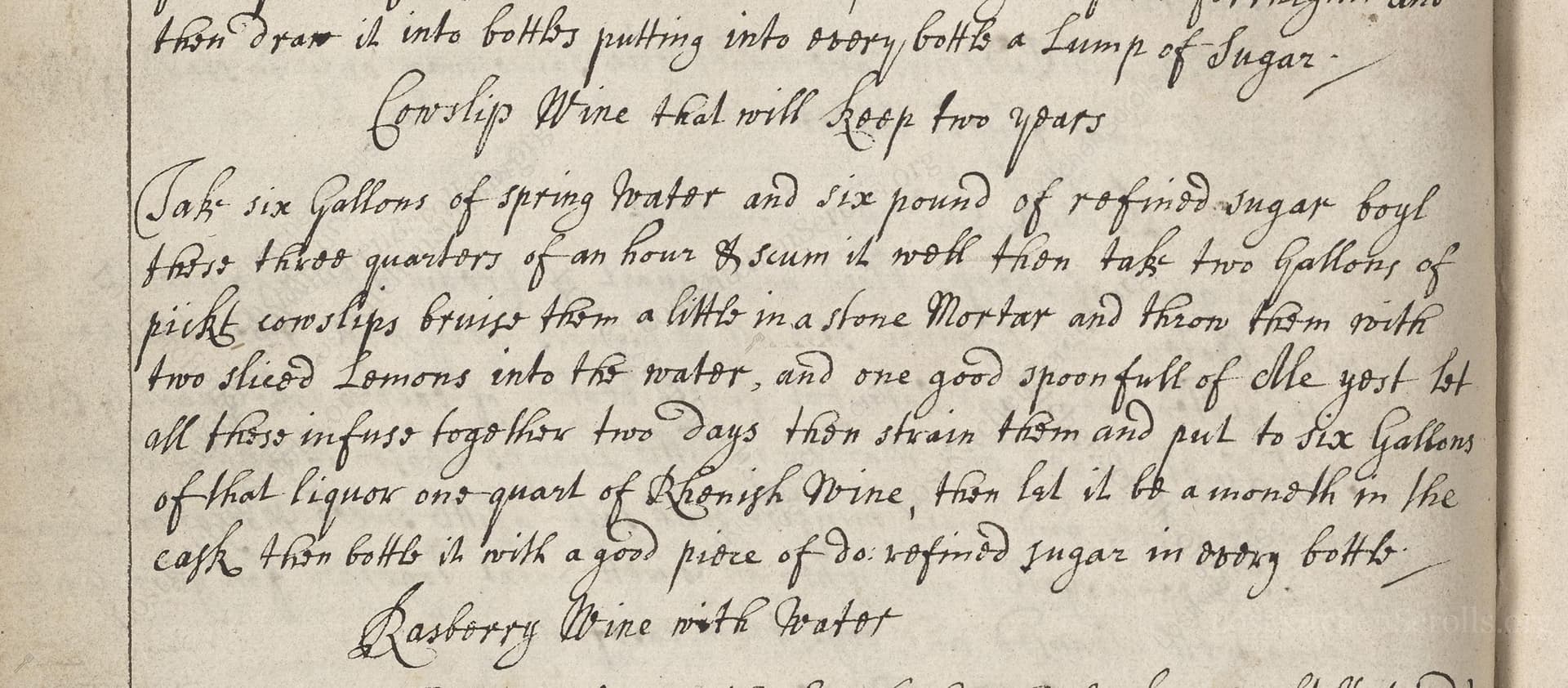Cowslip Wine That Will Keep Two Years
From the treasured pages of Receipt book
Unknown Author

Cowslip Wine That Will Keep Two Years
"Take six Gallons of spring water and six pound of refined sugar boyl these three quarters of an hour & scum it well then take two Gallons of pickt cowslips bruise them a little in a stone Mortar and throw them with two sliced Lemons into the water, and one good spoonfull of all the yest let all these infuse togather two Days then strain them and put to six Gallons of that liquor one quart of Rhenish Wine, then let it be a monoth in the cask then bottle it with a good piece of do. refined sugar in every bottle."
Note on the Original Text
This recipe, like many of its era, is written in a continuous, semi-narrative style, assuming the cook’s familiarity with processes like boiling syrup, skimming, straining, and fermenting. Spelling was highly variable ('boyl' for boil, 'yest' for yeast), and precise measurements were less common. Directions are context-dependent, and quantities are sometimes inferred from the household scale of the ingredient ('a spoonfull of yest'). The evocative language – 'bruised a little in a stone mortar' – is intentionally minimal and expects some practical kitchen knowledge.

Title
Receipt book (1687)
You can also click the book image above to peruse the original tome
Writer
Unknown
Era
1687
Publisher
Unknown
Background
A charming culinary manuscript from the late 17th century, brimming with recipes that blend hearty tradition and a dash of Restoration-era flair. Perfect for those seeking a taste of historic feasts and flavorful ingenuity.
Kindly made available by
Folger Shakespeare Library
This elegant recipe hails from England, dated between 1679 and 1694, a period known for its blossoming enthusiasm for domestic and medicinal wines. Cowslip wine was especially prized for its delicate aroma and was often made in the springtime when the flowers were abundant in meadows. The recipe comes from a handwritten household collection, reflecting the gentry's interest in festive, healthful cordials as worldly trade and botanical knowledge expanded.

In the late 17th century, this wine would be crafted using an iron or copper cauldron to boil and mix the sweetened water. A stone mortar and pestle would be used to bruise the cowslip blossoms. The mixture would infuse in large wooden or ceramic tubs. Straining would be done with linen cloths or sieves, and fermentation would occur in wooden casks (oak or chestnut). Bottling was done in thick glass bottles, stopped with corks and often sealed with wax.
Prep Time
1 hr 45 mins
Cook Time
45 mins
Servings
30
We've done our best to adapt this historical recipe for modern kitchens, but some details may still need refinement. We warmly welcome feedback from fellow cooks and culinary historians — your insights support the entire community!
Ingredients
- 6 gallons spring water
- 6 lb refined white sugar
- 2 gallons cowslip (Primula veris) flowers, lightly bruised (substitute wild primrose if cowslips unavailable)
- 2 lemons, thinly sliced
- 0.4 oz active baker’s yeast
- 1 quart dry white wine (recommend Riesling or similar Rhenish-style wine)
- 2-3 oz extra refined sugar (approximately 0.35-0.5 oz per bottle) for secondary conditioning
Instructions
- Begin by bringing 6 gallons of fresh spring water and 6 pounds of refined sugar to a boil.
- Simmer gently for 45 minutes, skimming off any foam as it rises.
- Next, pluck approximately 2 gallons (loosely packed, or about 3-4 pounds) of cowslip flowers (Primula veris) – or wild primrose as a substitute if cowslips aren't available – and bruise them lightly with a pestle in a sturdy mortar.
- Combine the bruised flowers and two finely sliced lemons with the hot syrup and add one generous tablespoon (about 0.4 oz) of baker’s yeast.
- Allow this fragrant mixture to infuse at room temperature for 48 hours.
- Strain the infusion through a fine cloth into a clean fermenting vessel, and for each 6 gallons of strained liquid, add 1 quart (one bottle) of dry white Rhenish-style wine (such as Riesling).
- Pour into a sanitized fermentation cask and leave to mature for a month.
- Bottle the wine with a good chunk (about 0.35-0.5 oz) of refined sugar in each bottle to help with mellowing and a gentle sparkle.
- Age for up to two years for best results.
Estimated Calories
120 per serving
Cooking Estimates
You'll spend about an hour preparing and simmering the syrup, plus time to pick and bruise flowers—about 45 minutes. After that, there's a 48-hour wait for the infusion, and the main fermentation takes about a month. Prep and cooking are hands-on, but most time is passive. This makes about 30 standard wine bottles with about 120 calories per 150 ml glass.
As noted above, we have made our best effort to translate and adapt this historical recipe for modern kitchens, taking into account ingredients nowadays, cooking techniques, measurements, and so on. However, historical recipes often contain assumptions that require interpretation.
We'd love for anyone to help improve these adaptations. Community contributions are highly welcome. If you have suggestions, corrections, or cooking tips based on your experience with this recipe, please share them below.
Join the Discussion
Rate This Recipe
Dietary Preference

Den Bockfisch In Einer Fleisch Suppen Zu Kochen
This recipe hails from a German manuscript cookbook compiled in 1696, a time whe...

Die Grieß Nudlen Zumachen
This recipe comes from a rather mysterious manuscript cookbook, penned anonymous...

Ein Boudain
This recipe comes from an anonymous German-language manuscript cookbook from 169...

Ein Gesaltzen Citroni
This recipe, dating from 1696, comes from an extensive anonymous German cookbook...
Browse our complete collection of time-honored recipes



